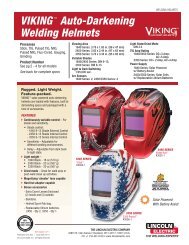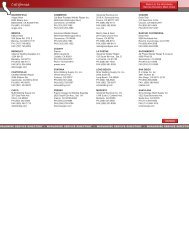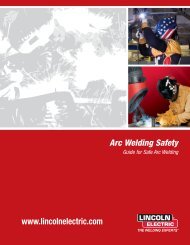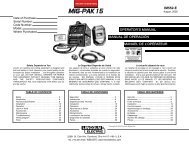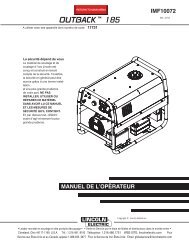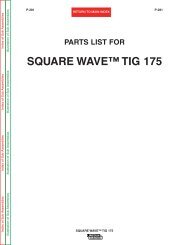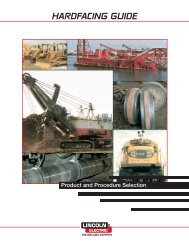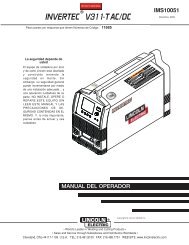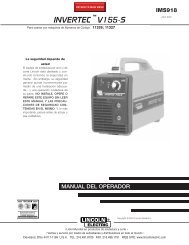E205 Arc Welding Safety - Lincoln Electric
E205 Arc Welding Safety - Lincoln Electric
E205 Arc Welding Safety - Lincoln Electric
You also want an ePaper? Increase the reach of your titles
YUMPU automatically turns print PDFs into web optimized ePapers that Google loves.
<strong>Safety</strong> Practices in <strong>Welding</strong><br />
INTRODUCTION<br />
<strong>Arc</strong> welding is a safe occupation when sufficient measures are<br />
taken to protect the welder from potential hazards. When these<br />
measures are overlooked or ignored, however, welders can<br />
encounter such dangers as electric shock, overexposure to<br />
fumes and gases, arc radiation, and fire and explosion; which<br />
may result in serious, or even fatal injuries.<br />
This bulletin is written with the arc welding operator in mind,<br />
containing both mandatory safety practices and those based on<br />
shop experience. Be sure to read ANSI Z49.1, and refer to the<br />
other publications listed at the end of the bulletin for more<br />
detailed information on specific topics of arc welding safety, as<br />
well as the manufacturers’ instructions and material safety data<br />
sheets (MSDS’s).<br />
PERSONAL PROTECTIVE EQUIPMENT<br />
Protective Clothing<br />
Welders, like firemen, must wear clothing to protect them from<br />
being burned. Of all injuries to welders, burns are the most<br />
common due to sparks landing on bare skin. <strong>Welding</strong> arcs are<br />
very intense and can cause burns to skin and eyes with just a<br />
few minutes of exposure.<br />
The actual gear varies with the job being performed, but<br />
generally protective clothing must allow freedom of movement<br />
while providing adequate coverage against burns from sparks,<br />
weld spatter, and arc radiation. Many types of clothing will<br />
protect you from ultra-violet radiation exposure, which appears<br />
as a skin burn (much like sunburn). Under the worst conditions,<br />
however, severe burns and skin cancer may result from excessive<br />
radiation.<br />
Because of its durability and resistance to fire, wool clothing is<br />
suggested over synthetics (which should never be worn because<br />
it melts when exposed to extreme heat) or cotton, unless it is<br />
specially treated for fire protection. If possible, keep your clothes<br />
clean of grease and oil, as these substances may ignite and burn<br />
uncontrollably in the presence of oxygen.<br />
Avoid rolling up your sleeves and pant-cuffs, because sparks or<br />
hot metal could deposit in the folds; also, wear your trousers<br />
outside your work boots, not tucked in, to keep particles from<br />
falling into your boots. While we’re on the subject, we suggest<br />
[2]<br />
Important Note:<br />
So that you can protect yourself against these hazards, every<br />
welder should be familiar with American National Standard ANSI<br />
Z49.1, “<strong>Safety</strong> in <strong>Welding</strong> and Cutting,” and should follow the<br />
safety practices in that document. Z49.1 is now available for<br />
download at no charge at:<br />
http://www.lincolnelectric.com/community/safety/ or at the<br />
AWS website http://www.aws.org.<br />
Download and read it!<br />
leather high-tops with steel toes (especially when doing heavy<br />
work).<br />
Other protective wear for heavy work or especially hazardous<br />
situations includes: flame-resistant suits, aprons, leggings,<br />
leather sleeves/shoulder capes, and caps worn under your<br />
helmet.<br />
Heavy, flame-resistant gloves, such as leather, should always be<br />
worn to protect your hands from burns, cuts, and scratches. In<br />
addition, as long as they are dry and in good condition, they will<br />
offer some insulation against electric shock.<br />
As to preventing electric shock, the key word is dry! We’ll have<br />
more on the subject later, but for now keep in mind that moisture<br />
can increase the potential for and severity of electric shock.<br />
When working in wet conditions, or when perspiring heavily, you<br />
must be even more careful to insulate your body from electrically<br />
“live” parts and work on grounded metal.<br />
ARC RAYS can burn.<br />
• Wear eye, ear and body protection.<br />
Note To <strong>Arc</strong> <strong>Welding</strong> Educators and Trainers:<br />
This <strong>Arc</strong> <strong>Welding</strong> <strong>Safety</strong> brochure may be freely copied for educational purposes if<br />
distributed to welders and welding students at no additional charge.<br />
WARNING<br />
<strong>Arc</strong> <strong>Welding</strong> <strong>Safety</strong><br />
www.lincolnelectric.com



